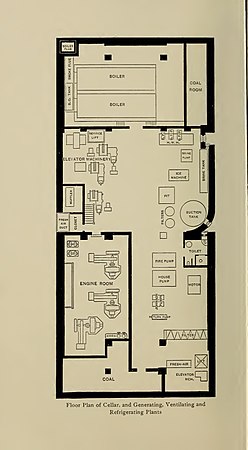
Carnegie Hall is a concert venue in Midtown Manhattan in New York City. It is at 881 Seventh Avenue, occupying the east side of Seventh Avenue between West 56th and 57th Streets. Designed by architect William Burnet Tuthill and built by industrialist and philanthropist Andrew Carnegie, it is one of the most prestigious venues in the world for both classical music and popular music. Carnegie Hall has its own artistic programming, development, and marketing departments and presents about 250 performances each season. It is also rented out to performing groups.
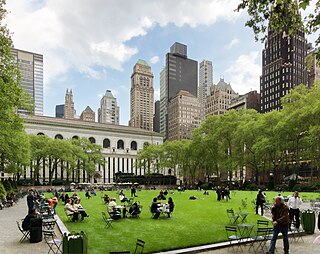
Bryant Park is a 9.6-acre (39,000 m2) public park located in the New York City borough of Manhattan. Privately managed, it is located between Fifth Avenue and Avenue of the Americas and between 40th and 42nd Streets in Midtown Manhattan. The eastern half of Bryant Park is occupied by the Main Branch of the New York Public Library. The western half, which contains a lawn, shaded walkways, and amenities such as a carousel, is located entirely over an underground structure that houses the library's stacks. The park hosts several events, including a seasonal "Winter Village" with an ice rink and shops during the winter.

Carnegie Hall Tower is a skyscraper at 152 West 57th Street in the Midtown Manhattan neighborhood of New York City. Completed in 1990 and designed by César Pelli, the building measures 757 feet (231 m) tall with 60 stories. Due to the presence of Carnegie Hall and the Russian Tea Room on adjacent sites, the tower is only 50 feet (15 m) wide on 57th Street, making it among the world's most slender skyscrapers at its completion.

The American Radiator Building is an early skyscraper at 40 West 40th Street, just south of Bryant Park, in the Midtown Manhattan neighborhood of New York City. It was designed by Raymond Hood and André Fouilhoux in the Gothic and Art Deco styles for the American Radiator Company. The original section of the American Radiator Building, a 338 ft-tall (103 m), 23-story tower, was completed in 1924. A five-story annex, to the west of the original tower, was built from 1936 to 1937.
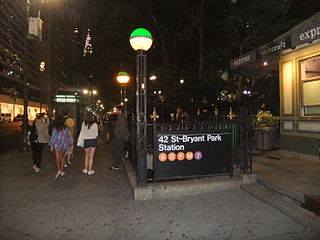
The 42nd Street–Bryant Park/Fifth Avenue station is an underground New York City Subway station complex, consisting of stations on the IRT Flushing Line and IND Sixth Avenue Line. Located at 42nd Street between Fifth Avenue and Sixth Avenue in Manhattan, it is served by the 7, D and F trains at all times, the B and M trains on weekdays, and the ⟨7⟩ and ⟨F⟩ trains during rush hours in the peak direction. A free passageway from the IND platforms to the Times Square–42nd Street/Port Authority Bus Terminal station, served by the 1, 2, 3, 7, <7>, A, C, E, N, Q, R, W, and S trains is open during the day from 6 a.m. to 12 a.m.

The Park Avenue Viaduct, also known as the Pershing Square Viaduct, is a roadway in Manhattan, New York City. It carries vehicular traffic on Park Avenue from 40th to 46th Streets. The viaduct is composed of two sections: a steel viaduct with two roadways from 40th to 42nd Streets, as well as a pair of roadways between 42nd and 46th Streets. The section from 40th to 42nd Streets was designated a New York City landmark in 1980 and was listed on the National Register of Historic Places in 1983. The street-level service roads of Park Avenue, which flank the viaduct between 40th and 42nd Streets, are called Pershing Square. The section of the viaduct between 42nd and 46th Streets travels around Grand Central Terminal and the MetLife Building, then through the Helmsley Building; all three buildings lie across the north–south axis of the avenue.

The IRT Powerhouse, also known as the Interborough Rapid Transit Company Powerhouse, is a former power station of the Interborough Rapid Transit Company (IRT), which operated the New York City Subway's first line. The building fills a block bounded by 58th Street, 59th Street, Eleventh Avenue, and Twelfth Avenue in the Hell's Kitchen and Riverside South neighborhoods of Manhattan.
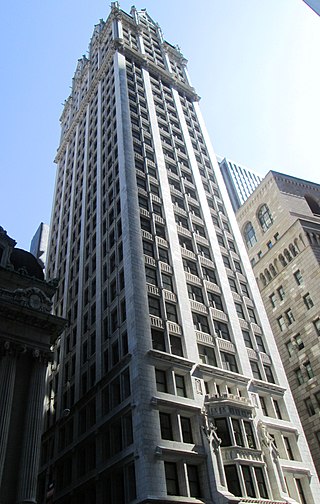
The Liberty Tower, formerly the Sinclair Oil Building, is a 33-story residential building in the Financial District of Manhattan in New York City. It is at 55 Liberty Street at the northwest corner with Nassau Street. It was built in 1909–10 as a commercial office building and was designed by Henry Ives Cobb in a Gothic Revival style.
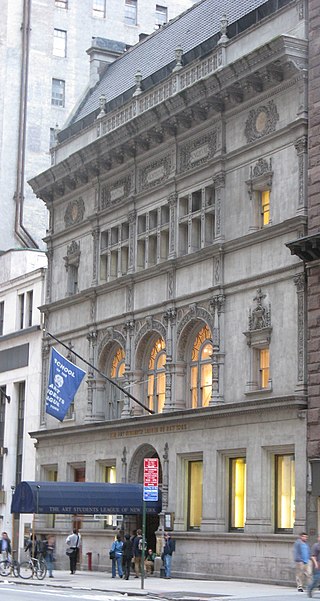
The Art Students League of New York Building is a building on 57th Street in Midtown Manhattan in New York City. The structure, designed by Henry Janeway Hardenbergh in the French Renaissance style, was completed in December 1892 and serves as the headquarters of the Art Students League of New York. The building was developed by the American Fine Arts Society (AFAS), formed in 1889 by five organizations including the Art Students League, the Society of American Artists, and the Architectural League of New York.

The Engineering Societies' Building, also known as 25 West 39th Street, is a commercial building at 25–33 West 39th Street in the Midtown Manhattan neighborhood of New York City, United States. Located one block south of Bryant Park, it was constructed in 1907 along with the adjoining Engineers' Club. The building was designed by Herbert D. Hale, of the firm Hale & Rogers, along with Henry G. Morse, in the neo-Renaissance style. It served as the clubhouse of the United Engineering Societies, composed of its three founding societies: the American Society of Mechanical Engineers (ASME), the American Institute of Mining Engineers (AIME), and the American Institute of Electrical Engineers (AIEE). The American Society of Civil Engineers (ASCE) joined the partnership in 1917.
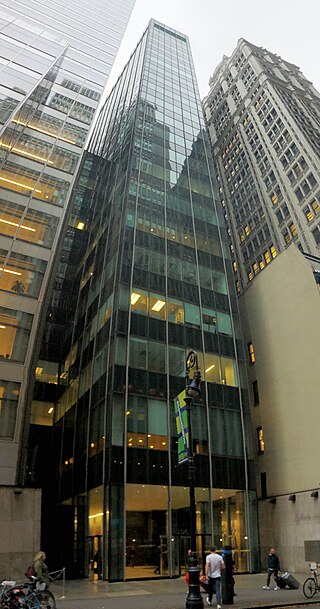
The Springs Mills Building is a 21-story office building at 104 West 40th Street in Manhattan, New York City, just west of Sixth Avenue and Bryant Park. The Modernist building sits on an L-shaped lot that extends back to 39th Street and rises to a thin glass hexagonal tower. An early example of the International Style in New York, the building was designed by the architectural firm Harrison & Abramovitz and built in 1961–1963. Its northern facade on 40th Street is designed to comply with the 1961 Zoning Resolution, enacted soon after the building's construction started, while its southern facade on 39th Street conforms to the older 1916 Zoning Resolution.
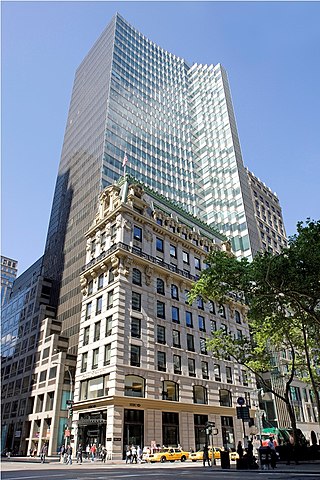
452 Fifth Avenue is an office building at the southwest corner of Fifth Avenue and 40th Street in the Midtown Manhattan neighborhood of New York City. The building includes the 30-story, 400-foot (120 m) HSBC Tower, completed in late 1985 and designed by Attia & Perkins. The 10-story Knox Building, a Beaux-Arts office building designed in 1902 by John H. Duncan, is preserved at the base of the skyscraper. 452 Fifth Avenue faces Bryant Park immediately to the north.

218 West 57th Street is a building on 57th Street in Midtown Manhattan in New York City. It was designed by Cyrus L. W. Eidlitz in the French Renaissance Revival style, with an annex built to designs by Eidlitz and Andrew C. McKenzie. The building served as the headquarters of the American Society of Civil Engineers (ASCE) from 1897 to 1917.

The Penn Club of New York is an American 501(c)7 not-for-profit, private social club located on Clubhouse Row in the Midtown Manhattan neighborhood of New York City. The club's 14-story building, which is a designated landmark, is located at 30 West 44th Street and initially was occupied by The Yale Club of New York City.

140 West 57th Street, also known as The Beaufort, is an office building on 57th Street between Sixth Avenue and Seventh Avenue in Midtown Manhattan in New York City. It was built from 1907 to 1909 and designed by Pollard and Steinam, who also simultaneously designed the neighboring, nearly identical building at 130 West 57th Street. The buildings are among several in Manhattan that were built in the early 20th century as both studio and residences for artists.
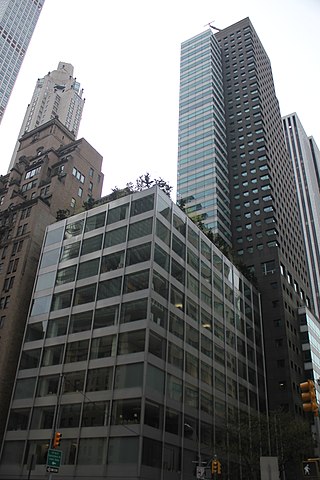
500 Park Avenue is an office and condominium building on the southwest corner of Park Avenue and 59th Street in the Midtown Manhattan neighborhood of New York City, composed of the 11-story Pepsi-Cola Building and the 40-story 500 Park Tower. The original Pepsi-Cola Building along Park Avenue was constructed from 1958 to 1960 and designed by Gordon Bunshaft and Natalie de Blois of Skidmore, Owings and Merrill (SOM). The tower along 59th Street was constructed between 1981 and 1984 to designs by James Stewart Polshek & Partners.

12 East 53rd Street, also the Fisk–Harkness House, is a building in the Midtown Manhattan neighborhood of New York City. It is along the south side of 53rd Street between Madison Avenue and Fifth Avenue. The six-story building was designed by Griffith Thomas and was constructed in 1871. It was redesigned in the Tudor-inspired Gothic Revival style in 1906 by Raleigh C. Gildersleeve.

275 Madison Avenue is a 43-story office building in the Murray Hill neighborhood of Manhattan in New York City. It is along the southeast corner of Madison Avenue and 40th Street, near Grand Central Terminal. The building, constructed from 1930 to 1931, was designed by Kenneth Franzheim in a mixture of the Art Deco and International styles.
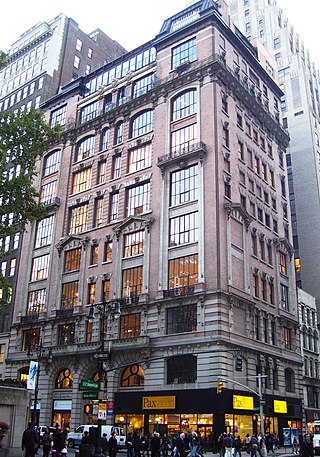
The Bryant Park Studios is an office building at 80 West 40th Street in the Midtown Manhattan neighborhood of New York City, at the corner of 40th Street and Sixth Avenue. The building, overlooking the southwest corner of Bryant Park, was designed by Charles A. Rich in the French Beaux-Arts style. Built from 1900 to 1901 by Abraham A. Anderson, the building is one of several in Manhattan that were built in the early 20th century as both studios and residences for artists.
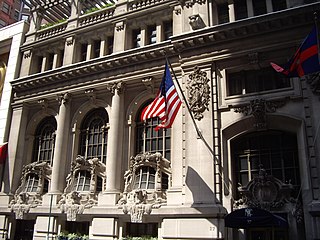
The New York Yacht Club Building is a seven-story Beaux-Arts clubhouse at 37 West 44th Street in the Midtown Manhattan neighborhood of New York City. Opened in 1901, the building was designed by architect Whitney Warren of Warren and Wetmore as the sixth clubhouse of the New York Yacht Club (NYYC). The clubhouse is part of Clubhouse Row, a concentration of clubhouses on 44th Street between Fifth and Sixth Avenues. The building is a New York City designated landmark and is listed on the National Register of Historic Places as a National Historic Landmark.





